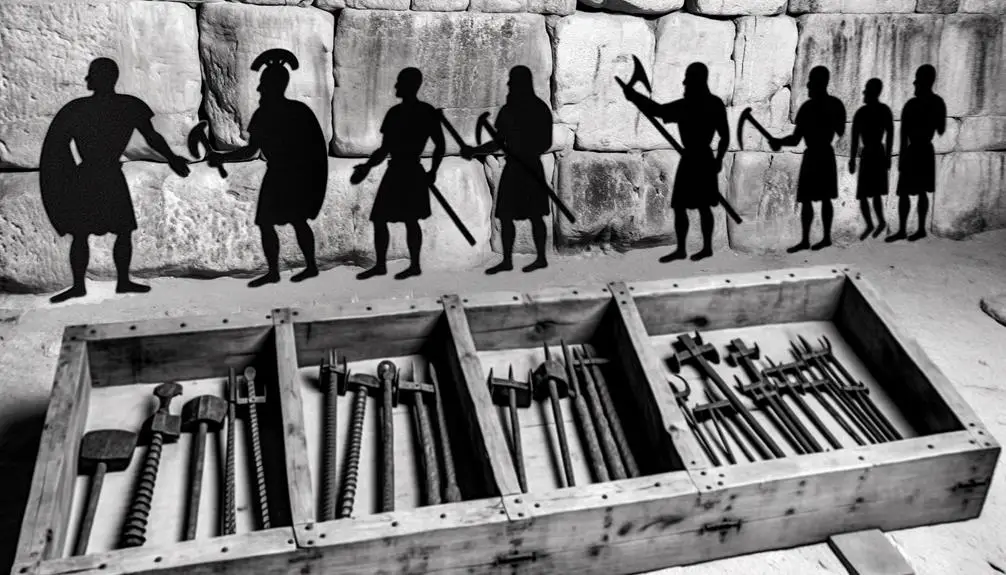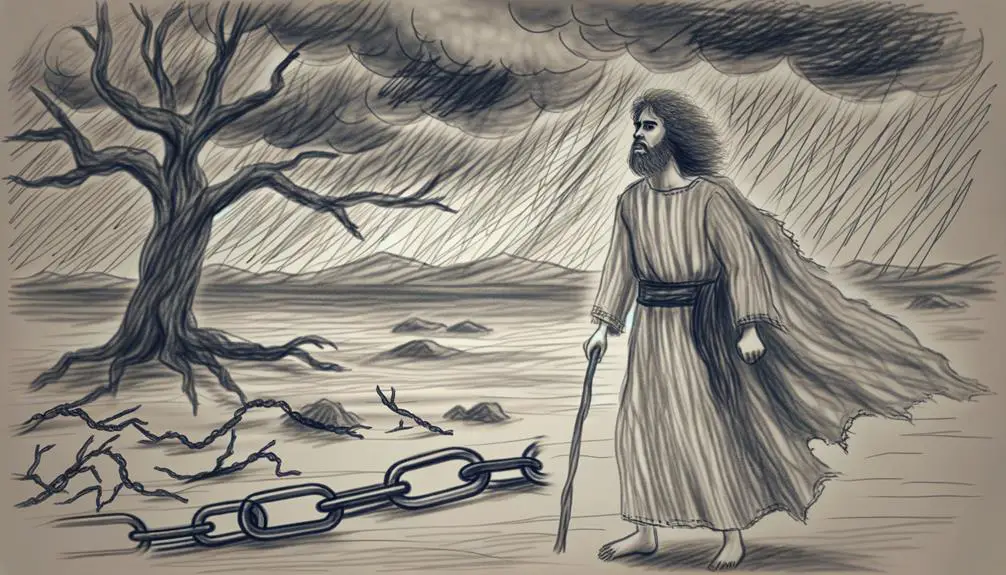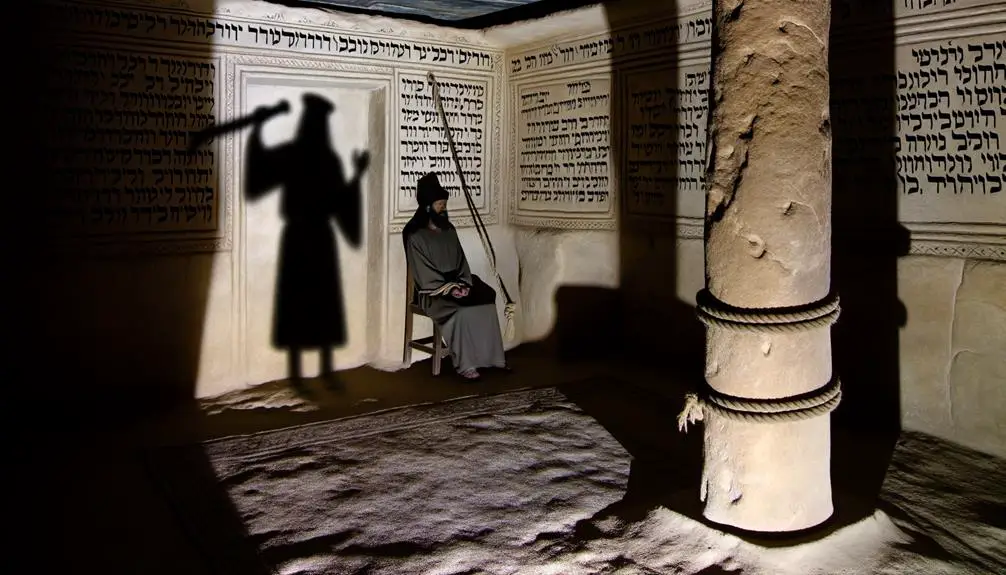Discover the profound implications of scourging in biblical narratives, revealing lessons on endurance and faith that echo through the ages.
Scourged in the Bible
As you scroll through ancient texts on your digital device, it's fascinating to consider how scourging, a form of punishment deeply rooted in history, is depicted in the Bible.
This practice, both brutal and symbolic, served various purposes from discipline to prophecy fulfillment.
Specifically, the account of Jesus Christ's suffering highlights the severity and significance of scourging in biblical times.
Exploring these narratives, you'll uncover layers of meaning about endurance, faith, and the human condition.
What lessons might these ancient practices hold for us today? Let's navigate this complex topic together, uncovering insights that resonate across centuries.
Key Takeaways
- Scourging served as a form of punishment and discipline within ancient Biblical societies.
- Prophets' sufferings, including scourging, were seen as divine tests strengthening faith and prompting societal reflection.
- In the Old Testament, scourging was regulated to balance justice, mercy, and discipline.
- Jesus's scourging symbolizes humanity's sins and underscores themes of sacrifice, redemption, and the importance of faith and compassion.
Historical Context of Scourging

Why did ancient civilizations resort to scourging as a form of punishment? At the heart of this practice, particularly within Roman practices, lies a complex interplay of cultural significance and social control mechanisms. You see, scourging wasn't merely a punitive measure; it was a deeply entrenched ritual that served multiple functions within the society.
Firstly, it's crucial to understand that Roman practices of scourging were meticulously codified. This wasn't arbitrary violence but a structured form of punishment, with the severity of the lashes often corresponding to the gravity of the offense. It communicated the state's power over the individual, serving as a stark reminder of the consequences of defying societal norms or laws.
Moreover, the cultural significance of scourging in ancient civilizations can't be overstated. It was a public spectacle, often carried out in open spaces where the community could witness the act. This visibility wasn't just about shaming the offender; it was a powerful tool of social cohesion. By witnessing the punishment, the community collectively internalized the values and laws of their society, reinforcing the social order.
In the Roman context, scourging also had a legal dimension. It was often a precursor to more severe penalties, including death. For non-citizens, under Roman law, scourging was a common preliminary to crucifixion, highlighting its role in the legal and social framework of the time.
Understanding scourging within these ancient civilizations requires looking beyond its immediate brutality. It was a complex institution, woven into the fabric of societal norms, legal systems, and cultural practices, playing a pivotal role in maintaining order and discipline.
Prophets and Punishment

Throughout history, many prophets faced severe punishments, including scourging, as a direct consequence of their messages challenging established societal norms and authorities. These stories, deeply embedded in religious texts, serve not only as historical accounts but also as profound moral lessons. The prophets' experiences with punishment, particularly scourging, reveal the intense struggles they endured for their unwavering commitment to their divine missions.
Here are three critical aspects to consider:
- The Role of Divine Retribution: Often, the punishment of prophets is depicted as a form of divine retribution, intended to test their faith or punish them for their or their community's transgressions. This concept underlines the belief that suffering can lead to spiritual purification and enlightenment.
- The Impact on Societal Norms: The prophets' punishments often acted as catalysts for change, challenging people to reflect on their actions and the moral fabric of their society. Through their suffering, prophets embodied the consequences of deviating from divine laws, urging societies to return to righteous paths.
- Lessons in Resilience and Faith: The narratives of prophets enduring scourging and other forms of punishment teach invaluable lessons about resilience, faith, and the power of conviction. Despite facing unimaginable hardships, their stories inspire believers to remain steadfast in their beliefs and moral principles, even in the face of severe adversity.
Analyzing these aspects helps us understand the multifaceted significance of prophets' punishments in religious texts. It's not just about the physical suffering endured but about the profound moral and spiritual lessons conveyed through their experiences.
Scourging in the Old Testament

Having explored the broader context of prophets' sufferings, let's now focus on the specific practice of scourging in the Old Testament and its implications.
Scourging, a form of physical punishment and humiliation, finds its roots deeply embedded within the ancient legal and religious frameworks of Israel. The Levitical laws, a cornerstone of Old Testament regulations, occasionally prescribed scourging as a disciplinary measure. Unlike sacrificial rituals that sought atonement and communion with the divine through offerings, scourging served as a direct, punitive response to certain transgressions against the community's moral and legal codes.
You'll find that the Old Testament doesn't shy away from depicting the harsh realities of its time, including the use of scourging. However, it's crucial to understand that such practices were regulated. The law imposed limits on the number of lashes to prevent death or severe injury, reflecting a balance between justice and mercy within the ancient legal system. This restraint underscores a fundamental respect for human dignity, even in punishment.
Moreover, the context of sacrificial rituals provides an interesting contrast to scourging. While both practices involve physical actions, sacrificial rituals are about restoration and reconciliation with God, highlighting a path to purification and renewal. In contrast, scourging is a corrective measure, a tangible consequence of one's actions meant to deter future offenses and maintain societal order.
Analyzing scourging in the Old Testament reveals a multifaceted approach to discipline, justice, and mercy. It's a testament to the complex interplay between law, society, and religion in ancient Israel, offering insights into how these early communities navigated the challenges of maintaining order and upholding moral values.
Jesus Christ's Suffering
In examining the New Testament, one can't overlook the profound and pivotal suffering of Jesus Christ, particularly his experience of scourging as a prelude to crucifixion. This act, both brutal and laden with meaning, serves as a cornerstone for understanding the depth of his sacrifice. To grasp the gravity of this event, consider the following aspects:
- Historical Context: Scourging, a common Roman practice, wasn't merely a form of punishment but a method to weaken a victim before crucifixion. Jesus's scourging was particularly severe, highlighting the extent of his suffering.
- Theological Implications: This suffering wasn't an end in itself but had profound theological implications, symbolizing the bearing of humanity's sins. It's a pivotal moment in Christian theology, underscoring the concept of sacrifice and redemption.
- Crucifixion Aftermath: The aftermath of the scourging, leading directly to the crucifixion, underscores the physical and spiritual climax of Jesus's earthly mission. His endurance through the scourging and the crucifixion aftermath provides a profound narrative of sacrifice and redemption.
Understanding Jesus's scourging requires you to delve deep into the historical and cultural context of the time, appreciate the theological implications of his suffering, and consider the crucifixion aftermath. This event isn't just a tale of endurance but a foundational moment that shaped the Christian faith.
It invites you to reflect on the depth of sacrifice made and the profound implications it holds for believers, encouraging a deeper appreciation of the Christian narrative.
Lessons of Endurance and Faith

The endurance and faith demonstrated by Jesus Christ during his scourging and crucifixion offer profound lessons for believers today. In the face of adversity, you're called to exhibit a similar spiritual resilience and unyielding faith. These are not merely historical anecdotes; they're the foundation for personal growth and spiritual resilience in today's challenging world.
Consider the following comparison to understand the impact of these lessons:
Aspect |
Lesson for Believers |
|---|---|
Endurance in Suffering |
Develops perseverance and character |
Faith Amidst Trials |
Strengthens trust in divine purposes |
Response to Adversity |
Encourages a compassionate, forgiving attitude |
Jesus' response to his trials provides a blueprint for you to navigate your own struggles. His endurance teaches you that suffering, while challenging, can lead to profound personal growth. It's not about the absence of pain, but about finding a purpose through it. His unshakeable faith amidst unimaginable agony illustrates the power of spiritual resilience. This isn't about blind optimism but about a deep-rooted belief in a greater plan and purpose beyond immediate understanding.
Moreover, Jesus' compassionate response to those around him, even in moments of intense personal suffering, highlights the importance of maintaining compassion and forgiveness, irrespective of the circumstances.
In essence, the lessons of endurance and faith depicted through Jesus' scourging and crucifixion are timeless. They encourage you to develop a spiritual resilience that not only withstands but also thrives in the face of adversity, fostering personal growth and a deeper, more meaningful faith journey.
Modern Reflections on Biblical Scourging

Reflecting on biblical scourging today, you'll find its lessons are as relevant now as they were centuries ago. The narratives, rich with historical and spiritual significance, beckon you to explore the ethical implications and societal perceptions that accompany the act of scourging. It's not just a relic of the past; it's a mirror reflecting our contemporary struggles with justice, mercy, and human dignity.
Here are three critical aspects to consider:
- Ethical Implications: The stories of biblical scourging challenge you to confront the ethical dilemmas surrounding punishment and retribution. They prompt you to question the morality of inflicting pain for the sake of discipline or deterrence, nudging you towards a deeper understanding of justice that transcends mere retribution.
- Societal Perceptions: These narratives also invite you to examine how societal perceptions of punishment have evolved. You're called to reflect on the ways in which modern societies have moved toward more humane forms of correction, and how these changes reflect broader shifts in ethical standards and values.
- Personal Reflection: Finally, the biblical accounts of scourging encourage personal introspection. They urge you to consider your own responses to wrongdoing and to reflect on the balance between justice and mercy in your life. This introspection can inspire you to cultivate a more compassionate and equitable approach to dealing with faults, both in yourself and in others.
In exploring these aspects, you're not merely revisiting ancient texts; you're engaging with timeless questions about human nature, justice, and redemption. The lessons of biblical scourging, viewed through the lens of modern reflections, continue to offer profound insights into how we understand and navigate the complexities of ethical and societal challenges today.
Frequently Asked Questions
How Has the Practice of Scourging Influenced Legal Systems and Punishment Methods in Contemporary Societies?
You're exploring how the evolution of corporal punishment has shaped modern legal systems and disciplinary methods.
This transition reflects global legal reforms aimed at more humane practices. Initially, physical punishment, including scourging, was common.
However, over time, there's been a significant shift towards rehabilitation rather than retribution. This change underscores a broader societal move towards respecting human rights and dignity, influencing how laws and punishments are structured today.
Are There Any Specific Archaeological Findings or Historical Artifacts That Directly Illustrate the Practice of Scourging in Ancient Times?
You're likely curious about whether there are tangible remnants from ancient times that showcase scourging practices. Indeed, scourging artifacts and historical depictions do exist.
Archaeologists have uncovered various relics, such as whips and images carved into walls or pottery, providing a vivid glimpse into past punitive measures. These findings not only confirm the use of scourging but also help us understand the societal and legal contexts in which they were applied.
How Do Different Christian Denominations Interpret the Significance of Scourging in Their Religious Practices and Beliefs Today?
Different Christian denominations interpret the significance of scourging in diverse ways, incorporating it into their beliefs and practices through metaphors and communal penance.
You'll find that some view it as a symbol of sacrifice and purification, while others see it as a call to personal and collective repentance.
This interpretation varies widely, reflecting each denomination's theological perspectives and traditions in a manner that's both analytical and respectful of their unique viewpoints.
Can You Provide Examples of How Scourging Is Depicted in Modern Media, Such as Films, Literature, and Art, and What Impact These Depictions Have on Public Perception?
You've likely seen scourging depicted in films, literature, and art, where its symbolism can shape public perception. These portrayals, underpinned by media influence, often evoke strong emotional reactions, highlighting suffering or injustice. By analyzing these depictions, you'll notice they're not just historical references but carry deep cultural and ethical implications.
This impact on viewers' understanding and empathy is profound, showing how powerful modern media's role is in interpreting and conveying such themes.
What Are the Psychological and Social Implications for Communities That Have Historical Ties to the Practice of Scourging, and How Do They Reconcile This Aspect of Their History With Modern Values?
For communities with a history of scourging, reconciling this past with modern values involves deep cultural healing and comprehensive historical education.
You're facing the challenge of understanding the psychological and social impacts, which can be profound.
Through education and acknowledging the past, you're not just moving towards healing; you're also fostering a more informed and empathetic society that values progress while respecting its history.
It's a delicate balance, but it's crucial for moving forward.
Conclusion
As you've journeyed through the stormy seas of history, you've witnessed how scourging, a tempest of pain, wasn't merely physical but deeply spiritual. It's a testament to endurance, a beacon of faith amidst the howling winds of suffering.
In the echoes of the past, you're reminded that these trials, though they may break the body, can also forge unbreakable spirits. Let these ancient lessons be your lighthouse, guiding you through the dark, reminding you that even in the deepest night, stars of hope and resilience shine bright.



Sign up